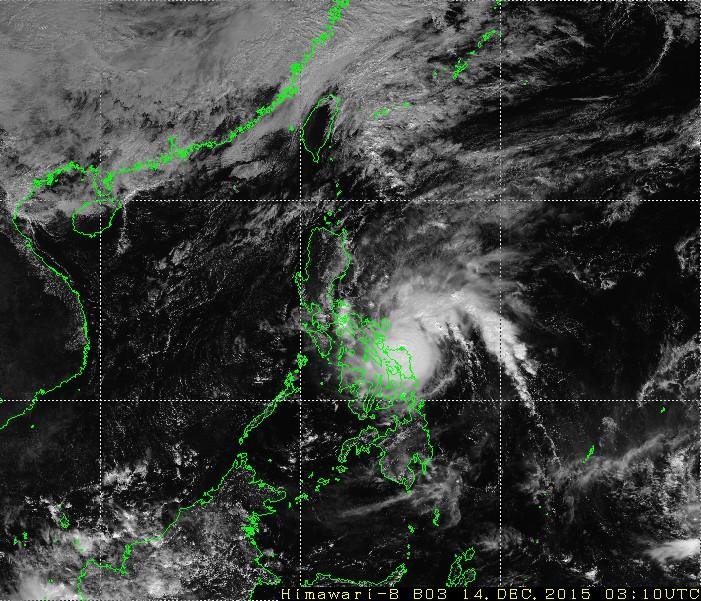Nona makes landfall in Batag, Northern Samar

PAGASA has confirmed that Typhoon Nona (International name Melor) made landfall in Batag, Northern Samar, at around 11 a.m. Monday. It will continue westward and is expected to make a second landfall in Sorsogon later this afternoon.
State weather forecasters underscored that the typhoon has a 400-kilometer radius, so its effects will be felt in places far from the point of landfall. Metro Manila and adjacent provinces, for example, are already under Storm Signal No. 1.
Nona gained strength over the weekend as it approached the Philippines, but maintained a strength of 150 kph and gustiness of up to 185 kph as of Monday noon.
Storm surges, storm signals
- Catanduanes
- Camarines Sur
- Albay
- Sorsogon
- Masbate, including Ticao and Burias Islands
- Northern Samar
- Eastern Samar
- Biliran
- Camarines Norte
- Marinduque
- Romblon
- Oriental Mindoro
- Occidental Mindoro
- Batangas
- Laguna
- Southern Quezon
- Leyte
- Metro Manila
- Bataan
- Luban Island
- Coron
- Cavite
- Rizal
- The rest of Quezon province, including Polillo Island
- Southern Leyte
- Northern Cebu, including Bantayan and Camotes Islands
- Aklan
- Capiz
- Northern Negros Occidental
- Northern Iloilo
- Dinagat province and Siargao Island
Lahar warnings
Meanwhile, PHIVOLCS has also cautioned against possible lahar flows in eastern Luzon and Visayas, particularly in the areas surrounding Mayon in Albay and Bulusan in Sorsogon.
 The Japan Meteorological Agency's Himawari weather satellite showed Typhoon Nona's (international name Melor's) eye hitting Batag Island in northern Samar at 11:10 a.m. Philippine Time.
The Japan Meteorological Agency's Himawari weather satellite showed Typhoon Nona's (international name Melor's) eye hitting Batag Island in northern Samar at 11:10 a.m. Philippine Time.
Effects as of Monday
Hundreds of thousands of people were evacuated from the central Philippines on Monday as a typhoon with winds of up to 150 kph (95 mph) made landfall, dumping heavy rain that could cause flooding, landslides and storm surges, authorities warned.
About 40 domestic flights were grounded, while 73 ferries and hundreds of fishing boats were ordered to remain in port as typhoon Melor hit the village of Batag on the northern tip of Samar island.
Known locally as typhoon Nona, it was expected to roll across nearby islands before making landfall later on Monday close to Sorsogon, about 385 km (240 miles) southeast of the capital, Manila, on the heavily populated main island of Luzon.
Melor was plotting a similar path to Haiyan, a category 5 typhoon that struck the central Philippines in 2013. Almost 8,000 people were killed or left missing by Haiyan.
Disaster authorities have temporarily closed schools and some offices and evacuated about 750,000 people in three provinces. About 8,000 people were stranded after the coast guard stopped ferries and fishing boats from leaving ports in the central Philippines.
"Melor is a very compact typhoon, so that will prevent its most devastating impacts from extending too far from its centre," said AccuWeather meteorologist Adam Douty.
He said the typhoon had weakened a little as it encountered drier air early on Monday. "While Melor will not slam onshore as a super typhoon as once feared, it still poses dangers to lives and property," Douty said.
Alexander Pama, executive director of the National Disaster Risk Reduction and Management Council, said typhoon Melor was expected to cause flooding, landslides and storm surges of up to 4 metres (13 feet) and disrupt power and communications.
About 20 provinces, some around Manila, are under public storm alert due to strong winds and torrential rains of up to 300 mm (12 inches) within a 300 km (185 miles) radius.
About 20 major typhoons pass through the Philippines each year. — With a report from Reuters, GMA News



